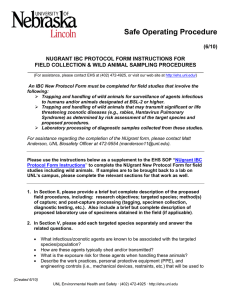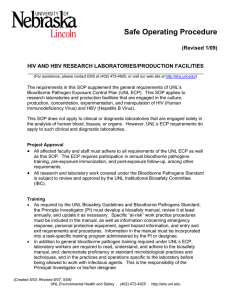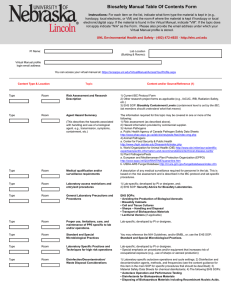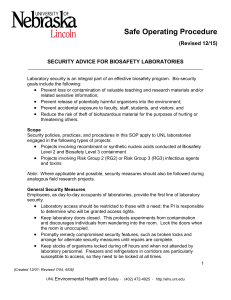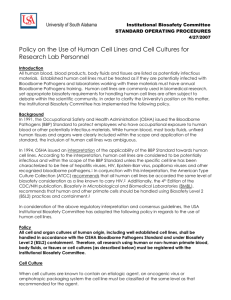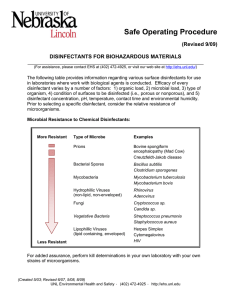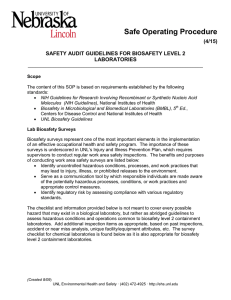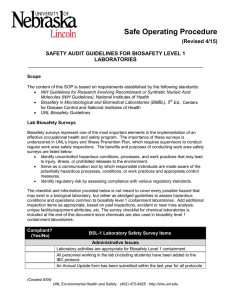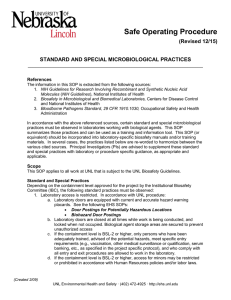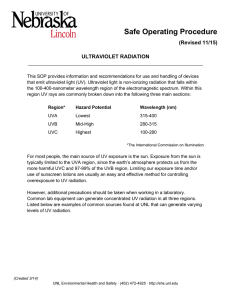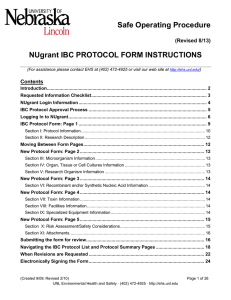Safe Operating Procedure (Revised 1/09) CELL AND TISSUE CULTURES
advertisement
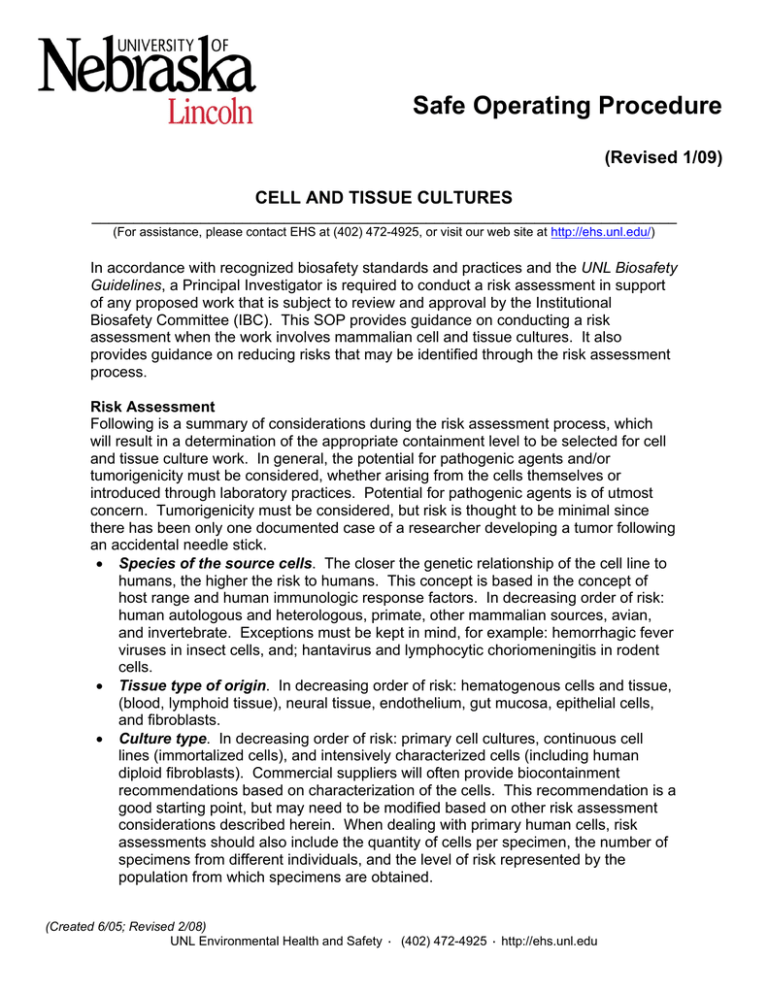
Safe Operating Procedure (Revised 1/09) CELL AND TISSUE CULTURES ______________________________________________________________________ (For assistance, please contact EHS at (402) 472-4925, or visit our web site at http://ehs.unl.edu/) In accordance with recognized biosafety standards and practices and the UNL Biosafety Guidelines, a Principal Investigator is required to conduct a risk assessment in support of any proposed work that is subject to review and approval by the Institutional Biosafety Committee (IBC). This SOP provides guidance on conducting a risk assessment when the work involves mammalian cell and tissue cultures. It also provides guidance on reducing risks that may be identified through the risk assessment process. Risk Assessment Following is a summary of considerations during the risk assessment process, which will result in a determination of the appropriate containment level to be selected for cell and tissue culture work. In general, the potential for pathogenic agents and/or tumorigenicity must be considered, whether arising from the cells themselves or introduced through laboratory practices. Potential for pathogenic agents is of utmost concern. Tumorigenicity must be considered, but risk is thought to be minimal since there has been only one documented case of a researcher developing a tumor following an accidental needle stick. • Species of the source cells. The closer the genetic relationship of the cell line to humans, the higher the risk to humans. This concept is based in the concept of host range and human immunologic response factors. In decreasing order of risk: human autologous and heterologous, primate, other mammalian sources, avian, and invertebrate. Exceptions must be kept in mind, for example: hemorrhagic fever viruses in insect cells, and; hantavirus and lymphocytic choriomeningitis in rodent cells. • Tissue type of origin. In decreasing order of risk: hematogenous cells and tissue, (blood, lymphoid tissue), neural tissue, endothelium, gut mucosa, epithelial cells, and fibroblasts. • Culture type. In decreasing order of risk: primary cell cultures, continuous cell lines (immortalized cells), and intensively characterized cells (including human diploid fibroblasts). Commercial suppliers will often provide biocontainment recommendations based on characterization of the cells. This recommendation is a good starting point, but may need to be modified based on other risk assessment considerations described herein. When dealing with primary human cells, risk assessments should also include the quantity of cells per specimen, the number of specimens from different individuals, and the level of risk represented by the population from which specimens are obtained. (Created 6/05; Revised 2/08) UNL Environmental Health and Safety · (402) 472-4925 · http://ehs.unl.edu • • • • • Media. Media used in cell line procedures derived from an animal may have contaminants. Media contaminants may grow when introduced to cell culture. The most common contaminant is bovine viral diarrhea virus (BVDV). Growing conditions. Altering culture conditions may produce surprising results. Changes in temperature, supplements, or growth surfaces can induce changes in oncogene expression or induce expression of endogenous viruses or alter interactions between recombinant virus and endogenous genomic provirus. Procedures. Procedures where aerosols are generated or procedures involving the use of needles or other sharps should be evaluated. Researchers are strongly encouraged to find alternate, less hazardous methods to conduct their research. Vectors. The hazards of vectors used with the cell line must also be considered when selecting an appropriate containment level (i.e., cells immortalized with viral agents such as SV-40, EBV, adenovirus or HPV). Bloodborne Pathogens. The Occupational Safety and Health Administration (OSHA) standard for Bloodborne Pathogens (BBP) may apply to laboratory workers who handle certain cell lines. OSHA has provided the following guidance: o Established human cell lines which are characterized to be free of contamination from human hepatitis viruses, human immunodeficiency viruses, and other recognized bloodborne pathogens are not subject to the BBP standard. o Established human or other animal cell lines which are known to be or likely infected/contaminated with human microbes or agents classed as bloodborne pathogens, especially hepatitis viruses and HIV, are subject to the BBP standard. o All primary human cell explants from tissues and subsequent in vitro passages of human tissue explants cultures (non-transformed, referred to by OSHA as human cell strains) must be regarded as containing bloodborne pathogens and are subject to the BBP standard, unless characterized by testing to be free of bloodborne pathogens. Compliance with the BBP standard requires offer of vaccination, training, and certain work practices. Refer to UNL’s Bloodborne Pathogen Exposure Control Plan (available on EHS website). Safe Practices In addition to the training provided by the individual researcher, use the following guidelines to ensure a safe working environment. • NEVER use autologous cells. Autologous cells, if accidentally reintroduced, can evade normal immune responses. • Workers must be trained in aseptic technique. • Use well characterized cell lines. • Read all information provided with the cells. • Quarantine new cell lines when they are brought into the laboratory. Continue separation until the new culture does not show growth of contaminating bacteria, fungi, or mycoplasmas. (Created 6/05; Revised 2/08) UNL Environmental Health and Safety · (402) 472-4925 · http://ehs.unl.edu • • • • • • • • • • • • • Use serum or protein free media if feasible and unwanted changes in the cell line will not be induced. Work with only one cell line at a time. Disinfect work area thoroughly before beginning work on a different cell line. When making media that will be used with more than one cell line, aliquot media into containers labeled separately for each cell line. This will reduce the chance of contamination. Restrict the use of antibiotics to reduce the chance of a resistant agent from growing. It is better to rely on good technique than on antibiotics to keep cell lines free of contamination. Avoid creation of aerosols: ♦ Do not create aerosols by mixing fluids with a pipette. ♦ Discharge pipettes against the wall of containers to avoid splashes. ♦ Special attention should be given when opening rubber-stoppered vessels. Use of sharps is strongly discouraged. Wear a buttoned lab coat or one that ties in the back. Wear personal eye protection and gloves. Goggles or face shields are required to protect against liquid splashes. Ensure that gloves and lab coat sleeves overlap to cover all parts of the lower arm and wrist. Wearing double gloves can provide additional protection. Layering gloves of two contrasting colors will increase visualization of small tears or holes. Outer contaminated gloves may be removed and replaced. Remove contaminated gloves carefully and wash hands with mild soap and warm water. Refer to the EHS SOP, Using Biosafety Cabinets for guidance on the safe use of biosafety cabinets. Check the airflow of the BSC to assure adequate exhaust before using. Plan ahead and take all needed supplies to the BSC before beginning work. Delineate areas for clean and dirty materials. Protect all vacuum lines with disposable air filters and/or liquid traps. Check the integrity of filters and fluid levels in traps before and after each work session. Change filters and disinfectant as needed. Filters must be autoclaved before disposal. Have a container of a bleach solution or other appropriate disinfectant ready for pipette tips or glass pipettes. Containers must be placed inside of the biosafety cabinet. Horizontal containers reduce the risk of aerosol production. Decontaminate all reusable glassware and plasticware immediately after use. Reference: Biological Safety: Principles and Practices, 4th Ed., ASM Press. (Created 6/05; Revised 2/08) UNL Environmental Health and Safety · (402) 472-4925 · http://ehs.unl.edu
